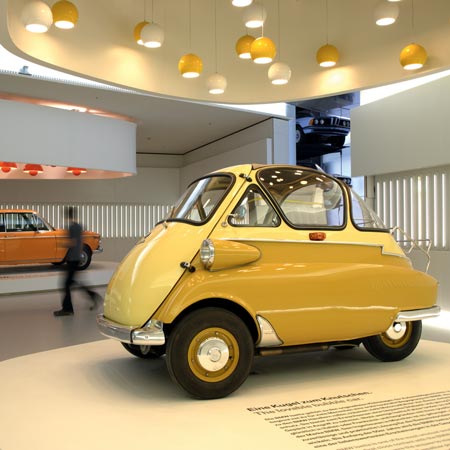
BMW Museum by Atelier Brückner
Architects Atelier Brückner of Stuttgart have designed the new BMW Museum, which opened in Munich last month.
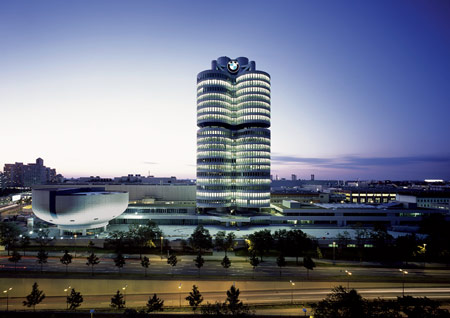
The project involved renovating the existing Museum Bowl (on the left in the photo above) - designed by Karl Schwanzer in 1973 - on the site of BMW's headquarters and adding a further 4000 square metres of exhibition space.
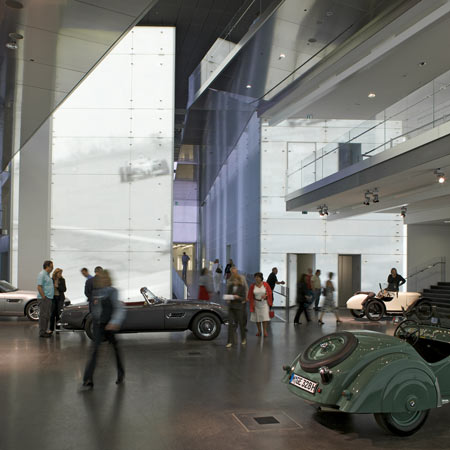
A kilometre-long ramp leads visitors through seven permanent exhibitions in the new three-storey building and temporary exhibitions held in the 5-storey Museum Bowl.
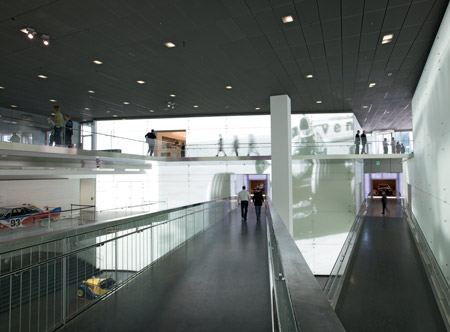
The museum has 125 exhibits on show, including cars, motorcycles, aircraft engines and racing engines.
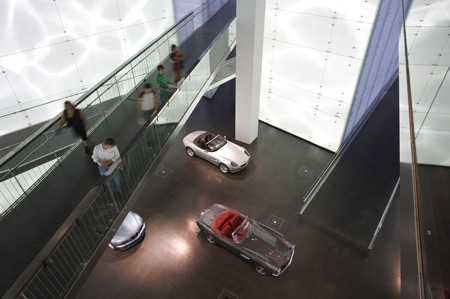
Building photographs by Markus Buck. Model photos by Sebastian Schröter. Renderings by ART+COM.
The following information is from BMW:
--
BMW Museum
Moves and Excites the Museum World: Dynamic Architecture
The new BMW Museum in Munich has a modern, dynamic language: the language of the automotive world. Opened on June 21st, 2008, it sets a new standard in the realm of brand-focused museums. Along with the BMW Welt, opened in October 2007, and the BMW factory tour, the museum is the final component of the BMW Triad, where two million visitors are expected annually.
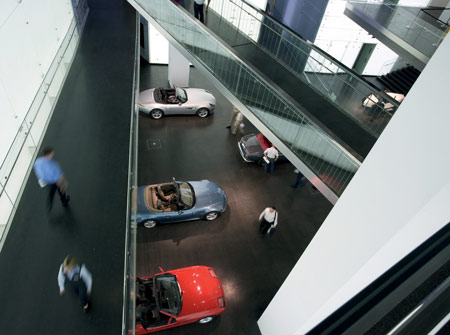
Analogous to the BMW brand, which stands for innovative technology and design, the BMW Museum takes new approaches to intertwining architecture, exhibition design and communicative media. The BMW Group could depend on an innovative realisation because of the experienced creative partners. The Stuttgart studio ATELIER BRÜCKNER was commissioned with the general planning, architecture, and exhibition design. ART+COM, a Berlin design office for new media, completed the spatial media design and interactive installations, while Integral Ruedi Baur executed the graphic design.
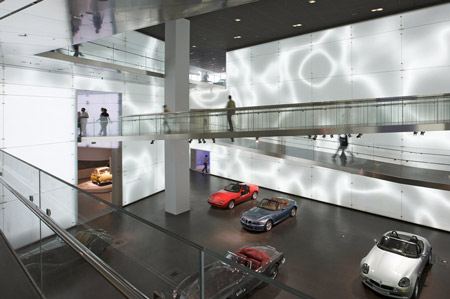
The initial call for the new BMW Museum came in 2003 when the BMW board of directors purposefully decided on the Munich location. In contrast to construction projects of other automobile manufactures, the new museum building would not originate in a green meadow; instead, it was a matter of integrating the new museum into the existing structural fabric of the group headquarters in Munich. Here, trendsetting architecture already had a presence from the original 1973 plans of the Viennese architect Karl Schwanzer. This ensemble consists of the “Four Cylinder” high-rise construction, the adjoining low buildings, and the “Museum Bowl” which carries the BMW logo on the roof, and has subsequently developed into a landmark of the car group.
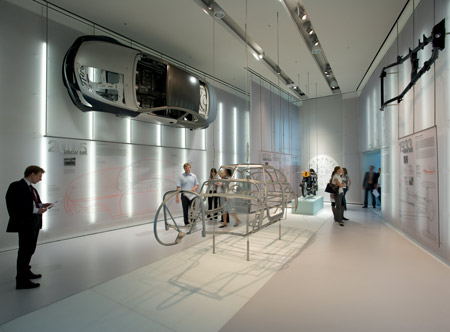
With the “Museum Bowl” Karl Schwanzer designed the first car-specific museum in Germany. Prominent pieces from the BMW collection were exhibited there. Prior to this, exhibits were only shown in the factory museum, built in 1966, although the collection began in 1922.

Schwanzer's basic idea for the museum building was the “continuation of the street in altered space“. The futuristic silver construction, which outwardly is very closed, looks light and generous inside. Via a rising spiral ramp, the visitor enters five seemingly free-floating platforms that serve as exhibition areas. The nearly circular base of the museum widens from approximately 20 metres to 40 metres in diameter. On platforms four and five, the wide airspace and building expansion becomes possible to experience.
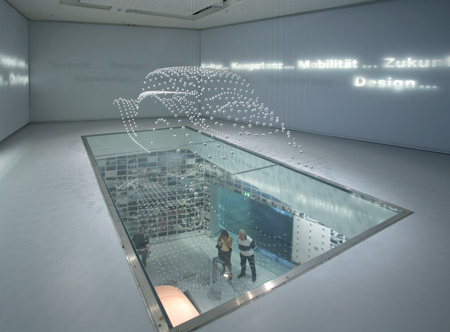
The job to interpret this prominent architectural piece anew and lead it into the 21st century was transferred to the studio ATELIER BRÜCKNER. It was a matter of maintaining the original architectural and experiential qualities of the “Museum Bowl”, making it suitable for installations, and uniting this part with a completely new long-term exhibition area. This new exhibition area was housed in an existing adjoining low building, the West Wing of the group headquarters that had served until then as an employee lounge and parking garage. The building was cleared to bearing walls by the Stuttgart architects and given a new dynamic interior. The exhibition space could now be extended from its former size of 1000 to 5000 square metres.
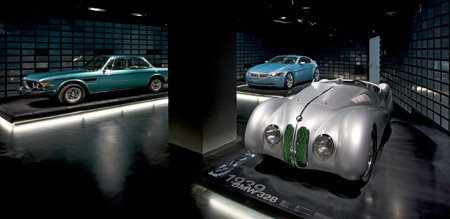
Ramp System
From the existing idea of Karl Schwanzer, the “street in altered space”, studio ATELIER BRÜCKNER developed a ramp system as a central motif for the architecture and exhibition. The ramp became the dynamic concept of the new architecture. As both a formed and forming element, the ramp takes on a key function. It leads the visitor through the museum and connects the new long-term exhibition with the “Museum Bowl”, now used for special exhibitions. In the end, a diverse perspective on vehicles, company history, and company philosophy is allowed by the ramp system. The experience of the fluent space leaves a lasting impression, drawing from the visual narrative of many single perspectives throughout the space.
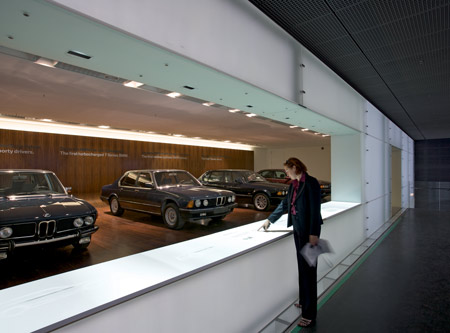
Upon the ramp, made to resemble a street-like path of polished asphalt, the visitor dives into the BMW brand. The uninterrupted walkway of about one kilometre length leads the visitor through the permanent exhibition and “Museum Bowl” spaces. Refined automobile-inspired architectural scenery with places and bridges surrounds the visitor. Additionally, the ramp system resembles a three-dimensional road, where one receives access to the exhibition houses on different floors.
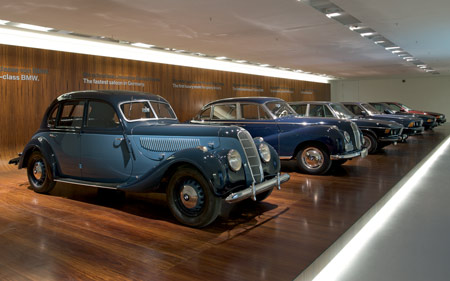
Exhibition Houses
Outwardly, the houses present themselves as homogeneous, luminous bodies with beaming bright glass facades. The interiors are similarly designed with a “White Cube” aesthetic, creating a visual relationship between houses. The differentiation occurs through the subject assigned to every house. These subjects include: Design, the Company, Motorcycles, Technology, Motor Sport, Series and the Brand. Each house speaks an independent and individual language that is generated from the subject. The identity of the houses can be seen on all floors. The individual exhibition rooms have common design elements, which consequently appear on the different floors and create a vertical and thematic arrangement.

The visitor enters the houses from the “street” – in each case where a small glass floor surface makes a clear visual statement of differentiation. Large doorways into the exhibits provide an unobstructed view into the house, providing a preview of the exhibits and sparking the curiosity of the visitor to lure them inside. Visual axes stress connections within a house as well as to neighbouring houses. For example, in the “House of Design” the design processes becomes more spatially experienced. The glass floor surface allows a look - forwards and back - in the other levels of the house. Between the “House of Technology” and “House of Motor Sport” there is a connecting axis that expresses the dependence of the areas both conceptually and architecturally; both doorways are aligned directly, allowing the respective exhibits to engage in direct dialogue.
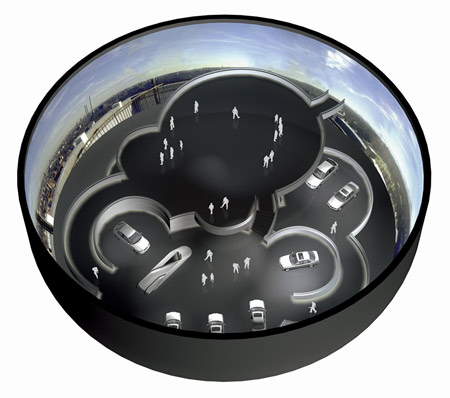
An original, authentic object stands in the centre of each exhibition and acts as a starting point for every single area. A reasonable thematic differentiation of the exhibition areas originates from it. The focus lies either on the object as the highlight of the area or the object groups are presented as direct lines of development from it. From this central space the aura unfolds undisturbed. Because of the common design base within each exhibition house every object or object group is emphasized according to a theme. Thus the spatial experience is developed and generated from the specific contents of the exhibition.
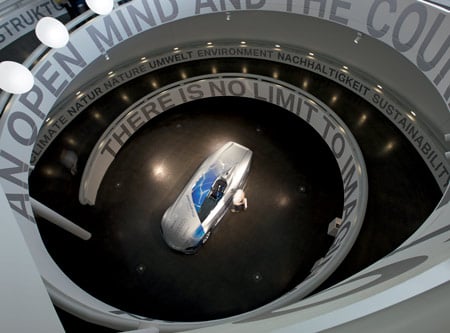
This approach is supported by the spatial media design that ART+COM individually developed in each room. Media choreography from projections, lighting, and sound reinforce the statements of the room and provide the stage for the exhibits. Interactive installations and so-called “Auxiliary” formats serve with secondary, in-depth information on the side. The visitor is actively involved in the exhibition events, causing surprise and emotion. The technical aspects, however, remain in the background. The installations do not stand apart, but are an integral component of the architecture and the entire production.

BWM Platz – Mediatecture
The climax of the media staging is undoubtedly the BMW Platz, developed by ATELIER BRÜCKNER collectively with ART+COM. It is the pulsating heart in the centre of the permanent exhibition, the nucleus of the exhibition house grouping. The visitor experiences this 13 metres high airspace several times while on the path, from different points of view; the critical viewpoint occurs as the visitor crosses the BMW Platz on a central bridge. Below the bridge, the parked vehicles on display almost seem to move as the multimedia light reflections progress across the cars, and architecture and scenery is briefly reflected in the polished varnish of the roadsters.
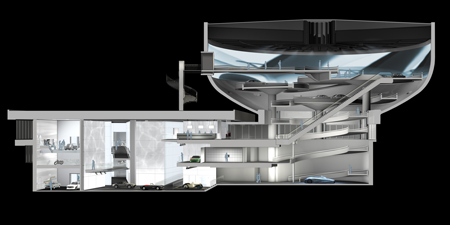
In the media lights displays of the BMW Platz, realised by ART+COM, space and spectator synch in movement. The facades of the space, about 706 square metres in size, were constructed with an LED technology where more than 1.7 million light-emitting diodes were used. Panes of glass hide the LED system, and collectively these components make up the “Mediatecture”. ART+COM has devised more than 30 possible lights displays, creating a technical atmosphere along with an additional poetic and emotional dimension where the architecture is dematerialised and given a new dynamic attitude.
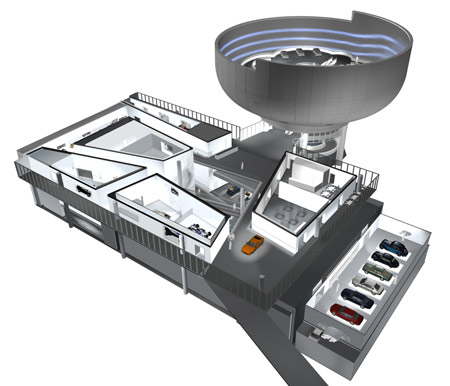
Through a series of experiments, the parameters were fixed to create an impressive spatial experience that adequately connected the brand to the architecture and media technology. The realised product works with monochrome white LEDs, which are mounted behind double glazed white windowpanes. This combination is new, used here for the first time. The windowpanes provide the impression – retained even at close range – of a uniform, closed picture where the technology is concealed from the visitor. One does not perceive the individual glass pieces as a defining element, instead discerning the overall glow from within the facade.
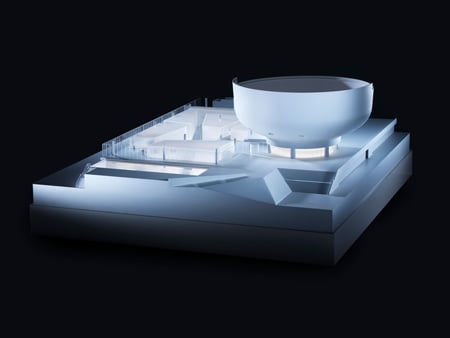
Altogether, a generous and ample impression is portrayed, supporting the “visual transparency” of other construction elements. Even the central crossing bridge path does not visually obstruct the space. Together with Schlaich Bergermann und Partner the Stuttgart architects of ATELIER BRÜCKNER developed an innovative glass bridge construction that uses weight-bearing glass in the side structures of the bridge. For the tension bracing of the bridge special steel typically used in racing yachts was chosen; it is thinner with higher tensile strength than regular steel. The end product is clearly a trendsetting and detailed innovation.
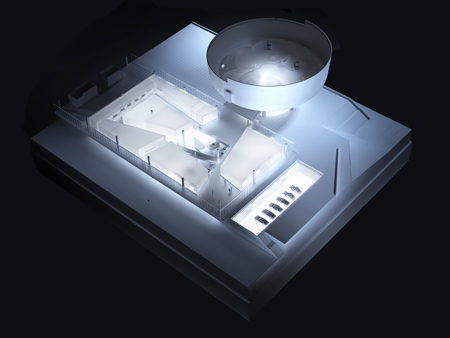
Street in Altered Space as a Principle of a Dynamic Architecture
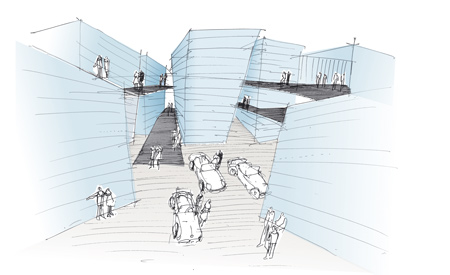 The original museum concept of Karl Schwanzer found a contemporary interpretation in the new building, namely the “street in altered space as a principle of a dynamic architecture“ (Prof. Uwe R. Brückner, head of the Stuttgart ATELIER BRÜCKNER). The proverbial "driving pleasure" was interpreted as a spatial experience. A dynamic, innovative architecture has emerged, where the leading idea of the “continuation of the street in altered space” is taken and transferred to a ramp system. The media productions lift “the limitations of the room and put exhibits and content in motion” (Prof. Joachim Sauter, creative director, ART+COM). Above sketch by Prof. Uwe R. Brückner.
The original museum concept of Karl Schwanzer found a contemporary interpretation in the new building, namely the “street in altered space as a principle of a dynamic architecture“ (Prof. Uwe R. Brückner, head of the Stuttgart ATELIER BRÜCKNER). The proverbial "driving pleasure" was interpreted as a spatial experience. A dynamic, innovative architecture has emerged, where the leading idea of the “continuation of the street in altered space” is taken and transferred to a ramp system. The media productions lift “the limitations of the room and put exhibits and content in motion” (Prof. Joachim Sauter, creative director, ART+COM). Above sketch by Prof. Uwe R. Brückner.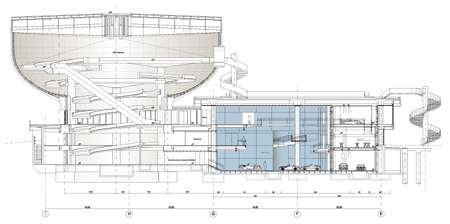
In Munich an original automobile museum has emerged where architecture, content, statement, and creation interlock. They go hand in hand for an aesthetically demanding, consistent space that corresponds to the BMW brand. The museum fascinates through the origination of unique and individual solutions – in architecture, scenography, as well as the area of the new media technology.
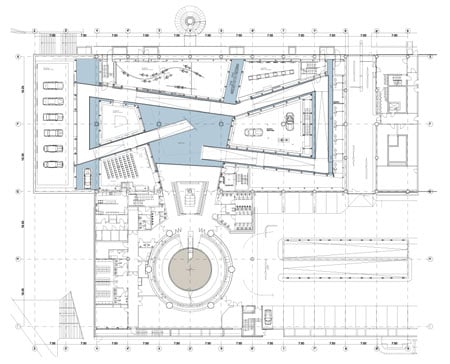
A tour of the BMW Museum – A Scenographic Exhibition
The new BMW Museum in Munich fascinates through use of unique, individual solutions in architectural scenography. After 2.5 years of construction, the project opened in June 2008.
BMW Platz
There are two entrances into the museum, one past the Museum Shop and one adjacent to the Café Bar M1, both which lead into the exhibition. The entrance hall opens to provide a look into the pulsating heart of the new museum, the BMW Platz, which the visitor will walk through several times and experience from different perspectives. The Platz speaks a dynamic, elegant, and urban language. Wide glass facades, polished high-grade steel, and a jointless ground from Bitumenterrazzo (polished asphalt) express a spatial perception that is not static, but in constant movement. The facades of the exhibition houses surrounding the BMW Platz were designed as “Mediatecture”, a symbiotic combination of media and architecture. This display shows abstract and thematic motifs expressive of BMW “driving pleasure”, functioning as an oversized table of contents for the entire museum.
This is the prologue of the exhibition. Here the visitor plunges into a genuine automobile museum world. One moves forward, as if on a road, attracted by individual exhibits where visual axes are deliberately positioned. In the preview area, three BMW compact class cars lure the visitor into the building; then it is the BMW Art Cars in the gallery and the BMW Roadster in the BMW Platz that draws them in further. Through the “Mediatecture” lights display, the cars appear to be in motion as architecture and landscape passes over them. The result is a moving and evocative impression of advancing space, all with homogeneity and austerity. Here, vehicles play the main role, as the balance of colour contrasts with the architectural sphere, which is marked by white and grey tones. This artistic motif extends through the entire exhibition.
A seemingly weightless ramp system dynamically reaches into the space and attracts the visitor into the depth of the exhibition. From the ramp the visitor can reach the individual exhibition houses. The facades, which were closed within the BMW Platz, are now open to provide access to the thematic worlds obtained from 90 years of BMW history.
The BMW Museum puts the main focus, however, not on the history as a concluded chronology, instead presenting themes where the lines of development can be viewed. These begin in the past, direct the present, and inspire for the future. The houses of the museum are dedicated to the following themes: the Company, Motorcycles, Technology, Motor Sports, Series, and the Brand, each contained within an individual exhibition houses. The identity is generated from the issues that run consistently through all floors of the houses, where each floor speaks to a specific aspect of the overall theme.
The starting point for the various stagings within each house exists within the exhibit or developmental line of exhibits. It is at the heart of the individual exhibition spaces, which generally adhere to a neutral “White Cube” aesthetic. Starting with the content, this adds a level of differentiation within the “White cubes”; the meaning of the exhibition space derives from the objects.
House of Design
The tour starts with a glimpse into the future. As the visitor enters the parcour, they will access the “House of Design” into the initial space “Inspiration. Ideas in flux.” From the interplay of light, sound, and movement, the “flow of ideas” is staged, where experimentation comes before the process of design. A “Kinetic Sculpture”, consisting of 714 hanging metal balls, metaphorically translates the design themes into the room. The sculpture cycles through free and abstract shapes to typical BMW vehicle forms.
A vertical line of sight connects the imaginative studio space to the space of ideas and inspiration that lies below it. The studio is where the working process begins: forms accept figure. A clay car model is positioned centrally within the space. A musical collage of cello music, inspired by the work noises of scraping on the clay model, or a pen that darts about paper, build up the ambient sound. A graphic collage, illustrated by an overall pattern of 4,500 images, expresses the spatial experience.
The size and form of these images become mirrors inside the “Treasure Trove”, taking up the space below the studio. Here BMW design icons are reflected across rectangular fields. The goal of all design is achieved; a spotlight is on the valuable vehicles, standing on podiums within the darkened room, throwing their light back to the design process. A glass ceiling allows you to view the connection back
into the studio.
There, as well as in the “Treasure trove”, the BMW designers get a chance to speak by means of video and audio installations. Their statements stand in relation to the auditive levels in the “Inspiration” space.
House of the Company
The “House of the Company” neighbours the “House of Design”, situated on the opposite side of the street. In this house, different aspects of the enterprise history are introduced. The space “First steps. How it all began.” shows the early history of Bayerische Motoren Werke with the flight engine production in 1917 (“Beginnings in Lofty Flight”), the construction of the first motorcycle in 1923 (“Success on Two Wheels”), to the 1928 purchase of the vehicle factory in Eisenach and the entry of BMW in the automotive field (“First Steps on Four Wheels”). The exhibits are placed on a timeline, created through three-dimensional construction, with integral white and silver stripes. At suitable places, time window openings on the timeline allow further insight into the applicable eras regarding the manufacturing of the vehicles.
In other rooms of the house, the timeline creates time rooms. The lower level, “Aspects. Thought and Action.” proposes, as the name suggests, individual aspects of the company’s history. Issues of forced labour, quality and flexibility, confidence, customer orientation, enthusiasm, personal responsibility, communicative architecture, and global networking are presented. Oversized year dates arrange the topics in the history of the company. Each of these issues is presented in a separate, illustrated book, located on eight high desks that invite the visitor to leaf through the topics. By means of a tracking system, audio text applicable to the images is triggered and broadcasted to provide further information.
Within the “Chronology” room, the visitor receives a comprehensive overview of all products made by BMW. The spatial mood is mystical and dark. Intricate cello music supports the magic of the staging, forming an open atmosphere. In the midst of this space of sound, where the timeline sets the order of the room, is a 30 square metres table where the reputed “Corporate Sculpture” is positioned. It has a multitouch capability, where several visitors can simultaneously touch the table surface, retrieve different information, and become engrossed in the background of BMW history. Hundreds of information pieces and approximately 1,000 pictures are deposited in this interactive chronicle. At the spine of the table is a white band that consists of the model names and their respective years. One glance clearly reveals the rapid advancement of both the BMW automobile and the motorcycle.
House of the Motorcycle
BWM is the only premium manufacturer who develops both cars and motorcycles worldwide. Thus an entire house was dedicated to the motorcycle; it appears – upon exiting the “Chronology” room – as a gigantic inaccessible glass cabinet. Here, a valuable collection of two-wheeled vehicles is presented as aesthetic objects on the wall. Line graphics are milled in the high-grade steel wall behind each respective motorcycle, illustrating the innovations related to the vehicle. The graphics are marked with a red colour, immediately catching the eye. The innovations presented include, for example, the cylinder engine and the drive shaft of the R32, the first BMW motorcycle, produced in 1923. Or the first cylinder heads made of lightweight metal and the first hydraulically damped telescopic fork. The visitor experiences the variety of the products and their innovations by simply passing by. The details are clear without need for further depth. The ramp system leads the visitor past the showcase directly to the “House of Technology”, where individual technical aspects are more thoroughly examined.
House the Technology
Here the visitor first enters the space “Lightweight construction. Less is more.” This communicates how in car and motorcycles production the weight of the vehicles can be reduced through construction, technology, and material. Hanging scales draw attention to a BMW 500 cubic centimetre compressor machine and the grid frame of the BMW 328 racing sedan – the later is only 36 kilos! Transquieto, a microperforated acrylic glass, is used as a space making material, its light structure corresponding to the core statement of the house. Other levels of the house also utilize this material.
The lower level space uses Transquieto panels to elucidate the technical innovations in six-cylinder engines. Adjustable information boards with line drawings are mounted on the wall. They refer to the centrally positioned engine row, featuring models from 1933, 1936, 1968, 1978, 1990, and 2004. As in a sterile laboratory, the engines glisten beneath fluorescent lighting. Here, the core competence of BMW is presented; construction of the six-cylinder is one of the most important BMW engines since the founding of the enterprise. The showroom consequently bears the title, “Engines. The name: an obligation.”
The last room of the house focuses on aerodynamics, named “Aerodynamics. Shaped by the wind.” It has the look of a wind tunnel, formed with horizontal Tranquieto bands emitting synchronized light pulses. A large projection shows the forces and effects of aerodynamics on the vehicles, and how this is taken into account during the development process. The spatial sound arrangement was developed based on actual sounds from a wind tunnel, interpreted through music.
A multitouch-capable media installation provides further in-depth information. This so-called Infobar acts as a window-shaped design element integrated into the architecture. The other rooms in the “House of Technology” use an analogous media to exhibit contents.
House of Motor Sport
Technical advancements and innovations are usually a prerequisite for victory in racing. This is reflected in the exhibition design at the BMW Museum. The visitor gains direct access from the “House of Technology” to the “House of Motor Sport” by crossing a small bridge. From this connection a dialogue is established between the individual exhibits; the grid frame presented in the space, “Lightweight construction. Less is More.” is directly opposite a road-worthy BMW 328 Mille Miglia Coupe.
In the space of "Champions. The will to win." the coupe is the core of the whole choreography that produces the legendary racing victories of the standard BMW 328 sports car. The races are introduced on a map of Europe to provide geographical context. Films and pictures, which are projected onto the map, deliver additional information and reflect the fascination of the race and the vehicle. In a seat lounge adjacent to the projection, a speaker reports on the results of the five winning races.
These historic images and film footages are embedded in a sound collage, which runs through the entire house. Engine-inspired sounds are interwoven with other music that penetrates from the lower floors upwards. Because all floors of the house are connected spatially, music can be heard on all levels of the house.
The “House of Motor Sport” outlines the entire racing sport history of BMW. The uniform design element is a “passing landscape”, which expresses the speed of the vehicles – whether it concerns the BMW 328, specialized Formula One cars, motorcycles, or touring cars. A perforated hole pattern made of anodized aluminium, integrated with backlit film strips and text, clothe the exhibition rooms of all three floors. Appearing Screens play suitable film sequences as the viewer approaches. The films show the exhibits – statically staged in the exhibition – in real surroundings in the context of their time. Dynamism and mobility are the focus. They are alive.
Below the “Champions” space is the location of “Motorcycle racing. Success on two wheels and three.” It shows how BMW, since the end of the 1930s, through world records and racing successes is the most successful sports brand in Europe. These results were linked to the right bank in racing, and the associated ideal line. This curved, graphical band is marked in the ground. Ernst Jakob Henne, however, reached his 1929 world record of 279.5 kilometres per hour on a straight line. Consequently, a straight band on the ground is assigned to him.
The space “Touring cars. In the fast lane.” is the scenographic climax of the “House of Motor Sport” exhibition. Five exhibits are composed using media display performances. The use of documentary footage, sound, and dynamic lighting effects generate a tension-loaded racing atmosphere. Within the darkened room, pulsating lights come from backlit filmstrips. On the opposite side of the room, an emotional documentary plays, pulling the visitor and objects into the happenings. The surround sound comes from a rock band, expressing the drama of the events and the feelings of success and passion.
One can receive direct access from this room in the “House of Technology” to the adjacent exhibition space “Aerodynamics. Shaped by the Wind.” Therefore, spatial light relationships were synchronized to create a subtle connection between the two rooms.
House of the Series
As the path of the visitor continues, one approaches the “House of the Series” that presents the successful policies of the BMW model lines. This house is flanked by installations that were previously out of sight, which traverse the entire height of the building. A transparent and delicate-looking structure of platforms and wire ropes forms the class tower, where the BMW 520, BMW 323i, BMW 734i, and the BMW 633 CSi seemingly float in position. On the opposite side the “Rear Views” of the BMW cars appear in their colourful diversity. The nameplates arrange into an expansive, artistic installation and convey the diversity of the series.
In the exhibition house, two lines are particularly singled out. In the space “BMW 7 Series. Luxury in its most dynamic form.” there are six luxury sedans presented on a lustrous road surface made from East Indian Rosewood: pure luxury. Already the oldest forerunner of the BMW 7 series, the BMW 335 of 1939 set standards of sophistication, technology, and vitality. With its 90 horsepower six-cylinder engine, it was the fastest sedan in its class. More information about the valuable exhibits comes to visitors on the ramp. A 6 metres long interactive Infobar, designed like a window opening, also allows a free view back into the exhibit room.
The lower level space “BMW M models. M: the world’s most powerful letter.” moves the BMW M models into the limelight. They are presented, quite sportily, on a glimmering asphalt surface. The space demonstrates how in 1978 BMW became the first worldwide car manufacturer to create a sporty production series. The visitor can retrieve specific engine noises, linked to the motto “more power, more goose bumps”, with headphones. A special recording method enables a spatially impressive sound experience.
House of the Brand
The phenomenon of the BMW brand is exhibited, finally, in the “House of the Brand”, also accommodating the Café Bar M1, the Museum Shop, and a seminar space.
A continuous band element and an overhead light element run through the house, conceptually linking the exhibits and bar. The space “Advertising. Reflecting the times.” deviates from it. Here, the “sky” is appropriately located over the central, leather seating. The visitor is in the spotlight: it is about customer communications. The exhibits, however, are integrated into the continuous band, with no exposure to direct light. Posters, advertisements, and promotional films from the beginnings of the company to BMW today are put on display. They are arranged into three successive levels, and a special timing triggered by visitors, allows them all to be considered. This highlights both the development of the brand as well as the advertising media.
The personal commitment of the driver to their BMW car is included in the room “Encounters. Adventures and experiences.” While the “Advertising” room focused on BMW communication to its customers, this room flips roles and aims to highlight BMW customers and their thoughts of the brand. This area documents the personal experiences of custormers with their BMWs. The BMW Isetta and the BMW 2002 TI are identified as examples. These vehicles stand out on account of their exceptional popularity amidst the large number of BMW automobiles. They are not only classics of car history, but embody a sense of life and spirit of a certain time period. The exhibition design does justice to this meaning. The vehicles are singled out on platforms, beneath a sky light, where the style of the period is shown. Original Panton pendant lamps, Topan (Isetta) and Flower Pot (2002), throw light upon the public darlings.
A wealth of private pictures on a circulating band documents the relationship between the BMW drivers and their vehicles. In addition, the meeting of people with “their” BMW is reproduced in audio. BMW fans tell their personal anecdotes of cult models. The sound recordings are initiated by human presence; if a visitor sits down on one of ten wall-mounted folding seats, a narrative starts. A history is assigned to each folding seat.
Museum Bowl
This nostalgic and emotional conclusion of the parcours is the end of the permanent exhibition area. Crossing through the BMW Platz, visitors gain access into the infamous “Museum Bowl”, architecturally bound through the ramp system.
At the base of the “Museum Bowl” is the exhibition “Visions. Ways in the future.” that demonstrates BMW’s commitment in the field of sustainability and fuel reduction, while still increasing performance. The central exhibit is the BMW H2R record vehicle, a hydrogen car with an outer skin of carbon plastic, which can reach a speed of up to 200 kilometres per hour. This vehicle is also the ideal prelude to the first special exhibition shown in the “Museum Bowl”, “Concept Cars”.
The exhibition design accentuates the architectural quality of this spectacular room, which was freed of refurbished equipment on the occasion of the opening. Balls, made of translucent plastic and affixed on the handrail, giving a rhythm to the ramp. They include texts and graphic information concerning the exhibited automobiles and their chronological context. The Concept Cars are presented on rotary pedestals, which are illuminated from below.
A band of text accompanies visitors up the ramp. Concepts used in the first exhibition room, “Inspiration. Ideas in flux.” as a noun were reminiscent, appear renewed – now with verbs. Here, one can read, for example, “beyond conventions”, “changing attitudes”, “reduced complexity”, “permit renewals”, “responsibility”, and “networked thinking”. It is about “transfer”, “flexibility”, and “dialogue”.
Visual Symphony
In the uppermost portion of the “Museum Bowl”, on platforms 4 and 5, is a 360° panoramic projection. Like a whirlpool, the visitor is pulled up and lured into the “Visual Symphony”, the epilogue of the museum’s exhibition. All impressions of the roughly one-kilometre long tour are collected here once more and atmospherically expressed.
The visitor sits beneath a large, round tent roof. Daylight penetrates only from below, coming through elliptical windows incised in the circular bowl, bringing in a delicate bluish-yellow hue. The extraordinary space, free of columns, has a 120 metres length wall surface and up to 6 metres in height, allowing 360° of dynamic film performance on the inner wall of the building shell.
With the help of a film display the room opens for the automobile world. A total experience of space, image, and sound takes visitors into the wide, dynamic world of Bayerische Motoren Werke. 18 projections unite into a moving picture. The film performance is generated in real-time and is of endless length. Two main modes can be distinguished: the “Ambient Mode”, where the sound landscape is subtly composed of fragments of prior room narratives, and the “Highlight Mode”, where a fulminating three-dimensional soundtrack is a symbiosis of tonal composition, sound design, and acoustics. 126 loudspeakers and 64 channels have control equal to an orchestra. This impressive space-sound experience is a final highlight to the museum tour.
This layer of sound accompanies the visitor, finally, back to the entrance hall. One reaches this – as originally intended in the 1973 scheme – on an escalator running through the bowl and skirting through the exhibits.
In the entrance hall of the museum, the visitor is invited to linger in the Museum Shop and the Café Bar M1. From here one can observe the BMW Welt delivery centre, enjoy the Olympic complex, and contemplate impressions left by the museum. One is particularly reminded of the “Advertising” and “Encounters” rooms.
For job opportunities at Atelier Brückner, visit their company profile on Dezeen Jobs.
BMW Museum
Am Olympiapark 2
80809 Munich
Creative Partners:
ATELIER BRÜCKNER GmbH, Stuttgart
Master Planning, General Planning Museum
Architecture
Exhibition Design
Scenography
ART+COM AG, Berlin
Spatial Media Design
Interactive Installations
Integral Ruedi Baur, Zürich
Graphic Design
Visual Identity
Project Commencement: 2003
Start of Construction Work: November 1st, 2006
Opening Ceremony: June 19th, 2008
Public Opening: June 21st, 2008
Total Budget: 80 Million Euro
Exhibition Space: 5,000 m²
Net Total Area: 10,000 m²
Gross Floor Area: 12,200 m²
Uninterrupted Parcours: Approx. 1000 m Length
Levels: 3 in the Permanent Exhibition Area, 5 in the Special Exhibition Area (“Museum Bowl”)
Number of Houses: 7 Exhibition Houses
Number of Subjects: 25 Areas
Number of Exhibits: 125 (cars, motorcycles, aircraft engines and racing engines)